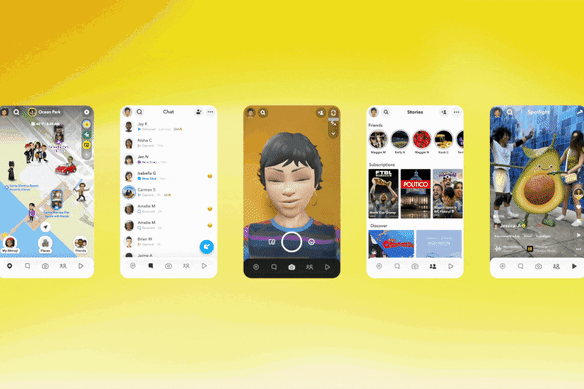- Exclusive
- Technology
- Social media
This was published 10 months ago
‘Parents already have the tools’: Snapchat billionaire pushes back on social media ban
By David Swan
Snapchat chief executive Evan Spiegel has weighed into Australia’s planned social-media age ban, declaring that parents are best placed to manage their children’s screen time, and already have the tools to do so.
Speaking exclusively to this masthead before Snap’s partner event in Los Angeles, Spiegel – who has three children with Australian model and businesswoman Miranda Kerr – said he and Kerr used options built into iPhones and iPads to control what their own children can access.

“Parents have already got these tools today”: Snapchat’s global chief executive and co-founder Evan Spiegel, with wife Miranda Kerr, weighs into Australia’s planned social media age ban.Credit: AP
Prime Minister Anthony Albanese’s announcement this month has kicked off a wave of debate over the merits and pitfalls of banning children and teenagers from social media, and raised questions about whether such a ban would be technically possible, given similar plans have failed overseas.
Meta Platforms – owner of Instagram, Facebook and WhatsApp – announced on Tuesday that it would roll out special accounts with new privacy settings for teenaged Instagram users in some countries, including Australia, as part of its efforts to limit the exposure of young people to harmful content.
Snapchat has long been a mainstay of Millennial and Gen Z Australians and would likely be in the crosshairs of any Australian ban, alongside other apps such as Instagram, Facebook, TikTok and X.
Spiegel is the first CEO of those apps to publicly comment on the government’s plans.
“Parents have already got these tools today,” Spiegel said. “We use the iOS-level controls and screen time to limit what our teen – we’ve got an almost 14-year-old at home – what he’s able to use. We have ‘family centre’ as well inside of Snapchat that allows parents to monitor their teens’ activity on Snapchat and put in place more stringent content controls and things like that.
“We’ve really done a lot to empower parents to make the right choices for their teenagers. And again, all those tools already exist for parents who would rather restrict the use of certain apps for their teens.”
The government has said its ban would tackle problems with bullying, sexting, aggression, sexualisation and other challenges for young people on the major social media platforms. It has not settled on a specific age for the ban or spelled out how it might be implemented. Snap has a minimum age of 13 globally and asks its users to enter a birth year to verify their age. It’s widely acknowledged that system can be easily bypassed by entering a fake birthdate, however.
Snapchat said in its recent submission to an Australian Senate committee that it supported device-level age verification as its preferred option, should legislation go ahead. It said users would need to confirm their age only once, rather than for each individual app, a process that also increases the odds that the information will be accurate.
“Age collection is already part of the device ID process when registering a new device, such as an iPhone or Android phone,” it said. “We believe that leveraging the potential of device-level age verification could drive significant progress in what has remained an intractable policy challenge until now.”
Spiegel also believes Snapchat is at fundamentally different to TikTok and Instagram. He doesn’t call Snapchat a social media platform, instead describing it as a place for friends to privately message each other, and says his app’s mental health and happiness outcomes are vastly different to that of its rivals.
“Snapchat’s always worked very differently than social media,” he said. “So far, I think research is really starting to validate what we’ve known for a really long time about our service, which is that it’s fundamentally different. I think Snapchat makes a positive impact.”
Snap on Wednesday announced a visual overhaul of its app, dubbed “Simple Snapchat”, in a bid to make it easier to use. The changes are rolling out to users incrementally.
Snap also unveiled the fifth generation of its augmented-reality glasses, Spectacles. At first, they’ll be available only to app developers as part of a $99 monthly subscription program, with a broader roll-out to consumers expected down the track.
For Spiegel, Spectacles represents a vastly different – and less screen-heavy – experience compared with virtual-reality headsets, such as Apple’s Vision Pro or Meta’s Quest.
He said the world was close to a future in which people would walk around the streets with some sort of smart device on their face. But he is quick to add that he thinks it’ll be smart glasses that gain rampant consumer adoption, rather than bulkier, heavier VR headsets, which he said could also often lead to motion sickness.

Snap has unveiled its fifth-generation Spectacles, which are augmented reality glasses.
”Ultimately, we feel like computing is really limited by screens. And so I think the promise of glasses, actually, is that we can transcend the screen and ultimately, build computing experiences that are much more immersive, much more fun and way more shareable than screens today, which I think sometimes can feel a bit isolating,” Spiegel said.
Snap’s share price is lagging some of its competitors and the overall market – its valuation sits today at around $US15.7 billion ($23.3 billion), compared with $US1.3 trillion for Meta – and Spiegel said that’s because its advertising business had grown more slowly than its competitors.
Snap has 8 million monthly active users in Australia Spiegel – who hasn’t visited Australia for a while, given he welcomed a newborn with Kerr in February – has immediate aspirations to hit a billion users globally.

Snapchat’s new-look app.
That would mark a significant milestone for the entrepreneur who started Snapchat at 21 with his Stanford University classmates Bobby Murphy and Reggie Brown.
“We’re, of course, continuing to evolve the core service. We’d love to reach a billion people,” Spiegel said.
”Around the world today, we’re at 850 million, so that feels like that’s within reach. In the coming years we’ll continue to develop our augmented-reality platform and help people interact with computing in a totally new way with our glasses.“
Get news and reviews on technology, gadgets and gaming in our Technology newsletter every Friday. Sign up here.